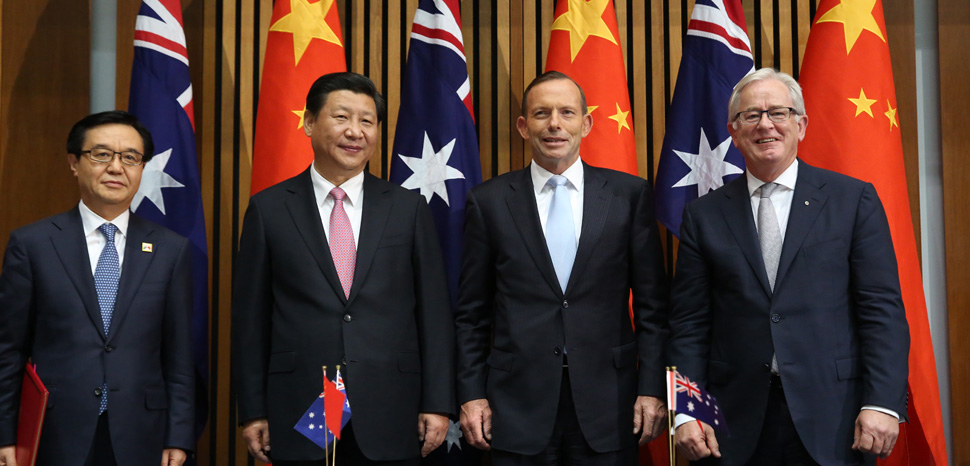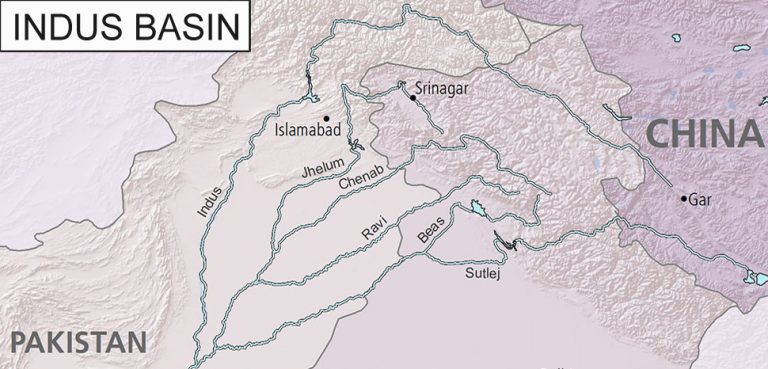December, 2015 – The China-Australia Free Trade Agreement (ChAFTA) comes into effect, removing trade barriers for goods and services and liberalizing bilateral foreign investment. In 2015, China absorbed about a quarter of all Australian exports.
December, 2015 – Australia becomes a founding member of the China-spearheaded Asia Infrastructure and Investment Bank (AIIB).
December, 2017 – Australia passes the Foreign Influence Transparency Scheme against the backdrop of a series of high-profile scandals involving CCP influence in Australian politics. Though the law itself is not targeted at any one country in particular, Prime Minister Turnbull’s use of the politically-charged phrase “the Australian people stand up,” and his open criticism of CCP influence in Australian politics generates diplomatic blowback in Beijing.
August, 2018 – Australia bans Chinese firms Huawei and ZTE from participating in building Australia’s 5G networks.
October, 2018 – China opens an anti-dumping investigation into Australian barley, an export trade worth $1.5 billion in 2018 and $960 million in 2019 (the decrease was due to drought).
January 23, 2019 – Yang Hengjun, an Australian citizen who once worked for China’s foreign ministry, disappears after soon after landing in China. He is later charged with espionage in October of 2020.
April, 2020 – Prime Minister Scott Morrison endorses an independent investigation into the origins of the COVID-19 pandemic, enraging the Chinese authorities. A series of new bilateral lows follows.
May, 2020 – China imposes an 80.5% tariff on Australian barley exports.
May, 2020 – Ships carrying Australian coal exports start encountering processing difficulties at Chinese ports. Fast-forward to November, 2020, and some 66 ships carrying Australian coal are docked off Chinese ports and awaiting processing. Such regulatory hurdles seem only to apply to Australian coal imports, and are presumably meant as a non-tariff trade barrier. Australia exported some $13.8 billion worth of coal to China in 2019.
June 9, 2020 – China’s Ministry of Education warns that Chinese students might face ‘racist incidents’ due to COVID-19 should they choose to study in Australia. The warning comes days after a similar alert was issued by the Chinese Ministry of Culture and Tourism advising against travel to Australia.
July 25, 2020 – Australia formally rejects the legal basis of China’s South China Sea claims in a declaration to the United Nations. The declaration makes explicit reference to the 2016 ruling by the Permanent Court of Arbitration ruled against the validity of China’s ‘nine-dash line’ ownership claims.
October 15, 2020 – Reports emerge that mills in China have been told to stop buying Australian cotton. China normally buys around 65% of Australian cotton, an export trade worth $800 million a year.
November 2, 2020 – Chinese companies scale back their purchases of a variety of Australian exports, reportedly upon receiving verbal instructions from the authorities. The list of targeted commodities includes coal, barley, copper, sugar, timber, wine, and lobster.
November 17, 2020 – Australia and Japan agree to a defense pact that paves the way for inter-operability and cooperation in the South China Sea (the joint statement cites ‘deep concerns’ over the SCS). Both countries belong to the Quadrilateral Security Dialogue, along with India and the United States – a non-binding security grouping that has been strengthening its bonds throughout 2020. The agreement marks the first defense agreement signed by Japan since its 1960 treaty with the United States.
November 18, 2020 – A list of ’14 grievances’ is delivered by the Chinese embassy in Canberra, highlighting the various policy positions that Australia needs to change to ensure a more harmonious relationship. The list includes: 1) ceasing funding to ‘anti-China’ research conducted by the Australian Strategic Policy Institute (a leading voice on CCP ‘sharp power’ methods); 2) ceasing raids on Chinese journalists and academic visa cancellations (likely in reference to the cases of Chen Hong and Li Jianjun); 3) ceasing support of Taiwan, Hong Kong, and Xinjiang-related issues in multilateral forums; 4) retracting calls for an independent inquiry into the origins of COVID-19; 5) reversing the decision to ban Huawei’s participation in Australia’s 5G network; 6) reversing the decision to block various Chinese foreign investment deals in the infrastructure and agriculture sectors, among others.
November 28, 2020 – China announces temporary tariffs on Australian wine exports, citing violation of anti-dumping rules. The tariffs range from 107-212%, and they follow an anti-dumping probe that was initiated earlier in the year. In response, the Morrison government indicates a willingness to take the case to the World Trade Organization (WTO).
November 30, 2020 – Chinese foreign ministry spokesman Lijian Zhao tweets a doctored image of an Australian soldier cutting the throat of an Afghan child, apparently in reference to the recently-released Brereton report alleging war crimes by Australian Special Forces in Afghanistan. The tweet ignites a full-fledged diplomatic row, with Prime Minister Morrison demanding an apology and the Chinese side refusing to oblige. Prime Minister Jacinda Ardern of New Zealand – another country with strong economic ties to China – joins Australia in condemning the tweet.
December, 2020 – With relations going from bad to worse, analysts begin to speculate that China could target Australian iron ore exports with tariffs. This would come as a major blow to Australian industry, as iron ore accounts for over half of Australian exports to China (and China now accounts for 39% of Australia’s total exports, 7% of its GDP). Iron ore wouldn’t be such an easy target though, given its status as a key input in China’s heavy industries – which explains why the commodity has yet to be singled out for punitive measures. Fast-forward to May 2021 and the bilateral trade is still booming with iron trading at decades-long highs.
December 1, 2020 – An editorial in the English-language, state-owned Global Times warns of ‘bitter pills’ to be swallowed if Australian warships come close to Chinese territorial waters – an allusion to Australia’s possible participation in Freedom of Navigation Operations in the South China Sea.
December 21, 2020 – The World Trade Organization (WTO) announces that Australia has lodged an official complaint over China’s tariffs on its barley exports.
March 28, 2021 – China imposes official anti-dumping tariffs on Australian wine, scaling up the temporary tariffs instituted in November 2020. Between December 2020 to April 2021, Australian wine exports to China dropped to just $12 million, down from $325 million the previous year.
April 22, 2021 – Australia foreign minister Marise Payne announces that the federal government will unilaterally cancel two Belt and Road deals agreed to by the government of Victoria state in 2018 and 2019. Both deals were broad memoranda of understanding and were legally non-binding. For more details, see Belt and Road Suffers Setbacks in Italy, Australia.
May 2, 2021 – A government source reveals to Reuters that Australia is reviewing a controversial 99-year lease for the port of Darwin, which was awarded to China’s Landbridge Group in 2015 (with sign-off from the Australian defense establishment at the time). For more details, see the Global Forecast for the week in question.
May 6, 2021 – China’s National Development and Reform Commission (NDRC) announces that it is suspending its participation in the China-Australia Strategic Economic Dialogue indefinitely. The annual platform, first founded in 2014, was instrumental in negotiating the 2015 China-Australia Free Trade Agreement (ChAFTA). However, as high-level talks have not been held since 2017, this was mostly a symbolic gesture on the part of Beijing.
May, 2021 – An unofficial ban of Australian coal remains in effect through the early months of 2021, with official Chinese customs data showing no imports since December. This has resulted in higher costs for China, which is the biggest importer and consumer of coal in the world. Chinese importers are being forced to turn toward US-sourced coal, which is up to 34% more expensive than Australian supply.
June, 2021 – Australian iron ore exports to China hit record levels, underscoring China’s enduring reliance on Australia for the key industrial input. Iron ore accounts for 80% of Australia’s total exports to China over the month.
June, 2021 – Beijing begins to enforce steel production controls meant to reduce pollution and overproduction in the domestic sector, impacting the profitability of Australia’s primary export. On June 15, iron ore (TIOC) was trading at $214/ton. Fast-forward to September 1 and the price had dropped to $142/t. Steel prices take off over the same period.
August 11, 2021 – Former prime minister Malcolm Turnbull remarks that Beijing’s campaign to “make [Australia] more compliant” has “completely backfired” in a roundtable organized by La Trobe University.
September 15, 2021 – A new trilateral security partnership is announced by the United States, United Kingdom, and Australia, dubbed “AUKUS.” The deal seeks to foster defense technology cooperation and interoperability between the three parties, and authorizes the transfer of nuclear submarine propulsion technology to Australia. Though China is not directly named in the text, it’s clear that AUKUS is meant to bring Australia onboard to the US-led Indo-Pacific security umbrella and bolster its military capabilities vis-à-vis the PLA Navy. For additional details, see the Situation Report from the week in question.
September 17, 2021 – Australia insists that China drops its sanctions and reopens ministerial-level trade talks as a prerequisite for commencing talks to joint the Progressive Agreement for Trans-Pacific Partnership (CPTPP) trade deal.
September 30, 2021 – Australia and India announce that the two sides will seek to implement a free trade deal by the end of 2022, in a development widely perceived as an attempt by Canberra to diversify its trading markets away from China.
December 8, 2021 – Australia joins the United States in imposing a diplomatic boycott of the Olympic Games in Beijing, 2022.
December 29, 2021 – Beijing raises import quota of Australian wool by 5% in a rare positive signal in bilateral trade relationship.
January 20, 2022 – Beijing formally challenges Canberra’s stance on railway wheels, wind towers, and steel sinks at the WTO.
May 21, 2022 – Anthony Albanese’s Labor Party prevails in the Australian general election, replacing Scott Morrison’s hawkish government and signaling the potential for a thaw in China-Australia relations, despite Labor taking a relatively harder line on China during the election campaign.
June 2022 – Wine Australia closes its office in Shanghai.
July 24, 2022 – New Australian Foreign Minister Penny Wong meets with China’s Wang Yi during G20 Summit in Bali.
August, 2022 – Australia initiates an anti-dumping investigation into Chinese aluminum extrusions.
November, 2022 – Trade Minister Don Farrell declares that Australia is willing to discuss ‘off-ramps’ with the Chinese government instead of forcing a WTO decision on ongoing trade disputes between the two countries.
December, 2022 – Foreign Ministers Penny Wong and Wang Yi meet in Beijing.
January, 2023 – China partially eases its unofficial ban on Australian coal, leading to a resumption of imports from what was once China’s second-biggest supplier.




